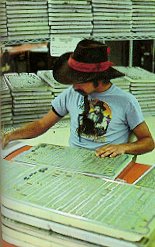| and you generate some kinds of outputs, and it's a feedback
system, and the player is in the loop of the feedback, and while he's giving the feedback
to the game, we hope he's getting some kind of enjoyment out of it." Which is how it all began, in the mind of Nolan Bushnell. A big, vigorous man with playful eyes who keeps a painted wooden clown and mounted papier-mâché zebra head in his office at his new robot-and-fast-food enterprise, Pizza Time Theatre, Bushnell is the man who figured out how to get the rest of us to love the computer, and who started Atari to do it. He first got the idea of video arcade games as an undergraduate at the University of Utah, where he played Spacewar games on the engineering lab computers at night, and supported himself by working at an amusement park in the summertime. It was while trying to convince strollers to toss baseballs at milk bottles to win stuffed animals they didn't really want, he recalls, that he realized what an attraction the engineering lab computer games would be on a midway. "But when you divide 25 cents into an eight-million-dollar computer, there ain't no way," he says, "so I sort of filed that concept in the back of my mind." In only a few years, however, the price of mini-computers came down so far that Bushnell, with a bit of electronics ingenuity, almost had the hardware for an arcade game worked out, using one minicomputer hooked to several TV terminals. The minicomputer was not quite powerful enough, so Bushnell added more computer circuits to the terminals to keep track of specific things, and he kept making the terminals' hardware smarter. Then he had a 25-cent idea. "I said, 'Hey, maybe I can do it all in hardware, and have a |
stand-alone terminal. And the minute that happened I worked
it out/and the economics were overwhelming. That was really how the first video game
started." That 25-cent idea changed the history of the computer, but no one knew it at the time. The legend is that Bushnell built the first game. Pong, in his garage. Actually, he moved his daughter out of her bedroom to build it, and it wasn't Pong. The first was a game called Computer Space, a flying saucer and rocket ship dogfight with turn, thrust and fire buttons, in a fiber glass cabinet. "The rocket ship followed Newton's third law—action and reaction—to ten percent accuracy," Bushnell says. Only 2,000 were made, but it was enough of a success to encourage Bushnell to build his next game. Pong, which became so popular and so widely distributed that almost everyone could get his hands on the hardware. The games were marketed through the traditional distributors of pinball machines and still are, except that they now make up about 80 percent of the business in many places. Many distributors at first showed no interest, and most thought the games would make a brief splash, then disappear from the market. The distributors still don't know quite what happened, or why. Despite an initial appearance in places where pinball was played, which led many people to see these games simply as a new sort of electronic pinball, the computer games are as different from pinball as the iron horse was from the horse. Pinball is essentially a game in which the player matches mechanical skills with a machine. It is the natural plaything of the industrial revolution, in -which machines created a mechanical advantage over human labor. The computer games are the first playthings of an information rev- |
|
|



